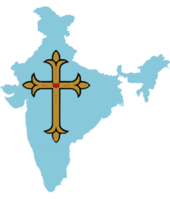Saint Thomas Christian cross
Saint Thomas Christian crosses are ancient crosses that belonged to the ancient community of Saint Thomas Christians of India, who trace their origins to the evangelistic activity of St Thomas the Apostle in the 1st century. It is thus one of the oldest Christian communities of the world.[1][2][3] Saint Thomas Christian crosses are broadly classified as Mar Thoma Sleeva (Saint Thomas Cross),[4] Indian Cross,[5] Persian Cross, and Nasrani Sthambam.
| Part of a series on |
| Saint Thomas Christians |
|---|
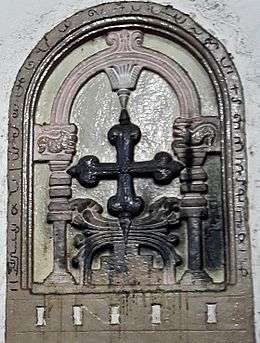 |
| History |
| Saint Thomas · Thomas of Cana · Mar Sabor and Mar Proth · Tharisapalli plates · Synod of Diamper · Coonan Cross Oath |
| Religion |
| Crosses · Denominations · Churches · Syriac language · Music |
| Prominent persons |
| Abraham Malpan · Paremmakkal Thoma Kathanar · Kayamkulam Philipose Ramban · Saint Kuriakose Elias Chavara · Varghese Payyappilly Palakkappilly · Mar Thoma I · Saint Alphonsa · Sadhu Kochoonju Upadesi · Kariattil Mar Ousep · Geevarghese Dionysius of Vattasseril · Geevarghese Mar Gregorios of Parumala · Geevarghese Ivanios · Euphrasia Eluvathingal · Thoma of Villarvattom |
| Culture |
|
Margamkali · Parichamuttukali · Cuisine · Suriyani Malayalam |


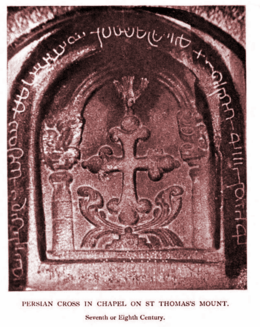
Mar Thoma Sleeva are found at Kadamattom, Muttuchira, Kothanalloor, Kottayam, Pallippuram and Alangad in the South Indian state of Kerala. Outside Kerala, they are found in Goa and Tamil Nadu in India, Anuradhapura in Sri Lanka and Taxila in Pakistan.[6] Flowery Indian Crosses are found at Kottakkavu, Pallipuram and Niranam.[7] The large open air rock crosses known as Nasrani Sthambams are found at the frontage of many Saint Thomas Christian churches in Kerala. It is recorded that before the arrival of Portuguese explorers there were more than 150 Syrian churches in Kerala.[8]
Mar Thoma Sleeha
Mar Thoma Sleeva is a Syriac term which means Saint Thomas Cross.[9] Antonio Gouvea, in the sixteenth century work "Jornada", states that the old churches of Saint Thomas Christians were full of crosses of the type discovered from S. Thome (Mylapore).[10] He also states that veneration of the cross is an old custom in Malabar. "Jornada" is the oldest known written document which calls the cross as St. Thomas Cross. The original phrase used is "Cruz de Sam Thome", meaning Cross of St. Thomas. Gouvea writes about the veneration of the Cross at Cranganore mentioning it as "Cross of Christians".[10]
Locations of Mar Thoma Sleeva
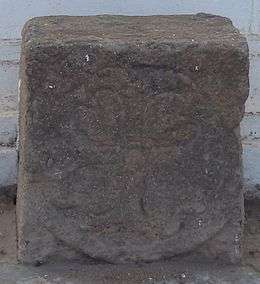
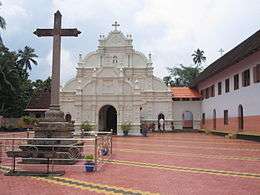
.jpg)
The crosses are at the following locations:[6]
- St. Thomas Mount, Tamil Nadu: The Cross is at Our Lady of Expectations Church under the Roman Catholic diocese of Chingelpet (Madras-Mylapore).
- Alangad, Kerala. This Cross is at St. Mary's Syro-Malabar Church under the Major Archeparchy of Ernakulam-Angamaly of the Syro-Malabar Church. This Cross is considered as the oldest cross in India.
- Kadamattam, Kerala. This Cross is at Kadamattom Church of the Oriental Orthodox Church.
- Muttuchira, Kerala. This Cross is at Ruha d' Kudsha Church under the eparchy of Palai of the Syro-Malabar Catholic Church.
- Kottayam, Kerala. This Cross is at Kottayam Valiapally (St. Mary's Knananya Church). One cross is considered of late origin (Ca 10th century).
- Kothanalloor, Kerala. This Cross is at St. Gervasis and Prothasis Church[11] under the eparchy of Palai of the Syro-Malabar Catholic Church.
- Agasaim, Goa. The Cross is now kept at Pilar Seminary Museum. This Cross is dated of 6th Century.
- Anuradhapura, Sri Lanka. The Anuradhapura cross is kept at Anuradhapura museum. It was found during excavations of Anuradhapura in 1912. This cross is considered as the oldest cross in Sri Lanka.
- Taxila, Pakistan. It is a very small cross that found in a field near the ancient city Sirkap near Taxila. The cross is kept at the Cathedral Church of the Resurrection, Lahore.[12][13] However, experts point out that the cross shares only one characteristic with other St Thomas Crosses that they are mostly equilateral, with arms of equal length. They claim that the Christian antiquity of this cross cannot be conclusively proven, as the same characteristic is also observed in pre-Christian Buddhist crosses and Swastika-variants found from the region, and even in the Greek Crosses.[13][14][15][16]
- An Indian Cross is depicted on the rock-piece at the front of the Parur (North) church, first published in The St. Thomas Christian Encyclopaedia of India, Vol.II, 1973, Ed. George Menachery.
- There is a St Thomas cross in stone on the porch of the Church of St Thomas the Apostle, Killinghall, carved by Charles Mawer of Leeds.[17]
Interpretation of the inscriptions
Arthur Coke Burnell, archeologist, in 1873, translated the inscriptions as follows:
- "In punishment by the cross (was) the suffering of this one;
- He who is the true christ, and God above and Guide ever pure."[18]
Prof. F. C. Burkitt and C. P. T. Winckworth, the then reader of Assyriology in the University of Cambridge studied the inscriptions and produced a translation. This has been discussed at the International Congress of Orientalists held at Oxford in 1925.
The interpretation is as follows:
- "My Lord Christ, have mercy upon Afras son of Chaharbukht the Syrian, who cut this (or, who caused this to be cut)."[19]
On the large cross, there is this additional sentence in Estrangelo Syriac. (Galatians 6:14)
- "May I never boast except in the cross of our Lord Jesus Christ."
The inscription at Kadamattom church when translated is,
- "I, the beautiful bird of Nineveh has come to this land. Written by me Shapper, who was saved by the Holy Messiah from misery."
Symbolism of Mar Thoma Sleeva
Unlike crosses in other traditions, the St. Thomas Cross does not carry the effigy of the Christ. In addition to this unique quality, each of its elements carry symbolic meanings. Generally the Cross symbolizes life rather than death and suffering.[20]
- Lacking the effigy of Jesus, the St. Thomas Cross presages the discovery of the empty tomb, glorifying the Resurrection of Jesus.[7]
- The four edges of the cross are floral in shape, symbolizing fruition and life from the tree of life.
- The lotus flower beneath the cross is a symbol of Buddhism and India. A cultural adaptation of local imagery, the cross fixed on the lotus would symbolize Christianity in India in the first century. The lotus is also a Puranic holy flower, an offering to God in the Hindu tradition; anything offered on the leaves of lotus is considered to be auspicious.
- The three steps below the Cross represent Golgotha, symbolically referring to the death of Jesus, also the three decks of the Ark and the ascent to Mt. Sinai.
- Finally, the dove above the cross represents the Holy Spirit, the third person of the Holy Trinity according to the Christian tradition. It is this spirit that raised Jesus from the dead and bestows gifts upon the Church's faithful.
Persian Cross
Kottakkavu Mar Thoma Syro-Malabar Pilgrim Church, North Paravur and St. Mary's Syro-Malabar Forane Church, Pallipuram under the Major Archeparchy of Ernakulam-Ankamaly of the Syro Malabar Church and St. Mary’s Orthodox Syrian Church, Niranam under the Niranam diocese of the Malankara Orthodox Syrian Church has the ancient, flowery Persian Cross.[7]
Nasrani Sthambam
Nasrani Sthambams are giant open air stone crosses.[21] The plinth of these crosses represents lotus petals and lotus flowers and has a square base. It also has a variety of iconographic motifs, including elephants, peacocks and various other animals to name a few.[22] These crosses are found in Puthenchira, Parappukkara, Veliyanad, Kalpparambu, Angamaly, Kanjoor, Malayattoor, Udayamperoor, Kuravilangad, Uzhavoor, Chungam, Kaduthuruthy, Muthalakodam, Muttuchira, Kudamaloor, Niranam, Arakuzha, Kothamangalam, Chengannur, Thumpamon, Chathannur and many other places.[23][24]
References
- The Encyclopedia of Christianity, Volume 5 by Erwin Fahlbusch. Wm. B. Eerdmans Publishing - 2008. p. 285. ISBN 978-0-8028-2417-2.
- The Jews of India: A Story of Three Communities by Orpa Slapak. The Israel Museum, Jerusalem. 2003. p. 27. ISBN 965-278-179-7.
- Cf. The first dozen articles in the St. Thomas Christian Encyclopaedia of India, Vol. II,1973, Ed. George Menachery
- Vazhuthanapally, ”Archaeology of Mar Sliba”.
- O'Flynn, Donnel (2017). Holy Cross, Life-Giving Tree. Church Publishing, Inc. p. 74. ISBN 978-0-8192-3368-4.
- "Analogical review on Saint Thomas Cross - The symbol of Nasranis-Interpretation of the Inscriptions". Nasrani.net. 29 February 2008.
- "Stone Crosses of Kerala". Nasrani.net. 16 January 2007.
- Malabar Manual by William Logan - 1996 published by Asian Educational Services
- NSD Network: Mar Thoma Sliba- Saint Thomas’ Cross- A religio cultural logo
- Antonio Gouvea," Jornada of Dom Alexis de Menezes"
- kothanalloorchurch.org
- Picture and description in the St. Thomas Christian Encyclopaedia of India, Ed. George Menachery, Vol.I, 1982 in article Christianity in Pakistan by Bishop Young,
- Rooney M.H.M, Fr. John (1984). Shadows in the Dark (Pakistan Christian History Monograph No. 1). Christian Study Center, Rawalpindi. pp. 42–45. Archived from the original on 18 March 2012.CS1 maint: BOT: original-url status unknown (link)
- Rashid, Salman (16 December 2011). "Taxila Cross - The Express Tribune". The Express Tribune. Retrieved 23 December 2017.
- Rashid, Salman (5 July 2014). "Taxila Cross". Retrieved 23 December 2017.
- Rashid, Salman (10 March 2013). "St Thomas in Taxila". Retrieved 23 December 2017.
- See image: File:St Thomas Killinghall 667.JPG
- On some Pahlavī inscriptions in South India (1873) by Arthur Coke Burnell, page 11
- The Journal of Theological studies (1929), P-241, NSC Network (2007)
- "St Thomas Cross". Thenazrani.org.
- name= "Menachery"Rock Crosses of Kerala, Article by George Menachery, 2000
- Rock objects in Kerala Churches, in George Menachery, Glimpses of Nazraney Heritage, SARAS, Ollur, 2005
- Menachery, George. "Rock Crosses of Kerala". 2007.
- George Menachery, Indian Church History Classics Vol.I "The Nazranies", Ollur, 1998. It has photos of dozens of Rock Crosses
External links
| Wikimedia Commons has media related to Cross of Saint Thomas. |

- St.Thomas Cross
- Analogical review on St Thomas Cross- The symbol of Nasranis
- Nasrani.net
- Menanchery article on Rock crosses of Kerala
- Daily News report on Crosses in Sri Lanka (Wayback Machine archived copy)
- Stone Crosses of Kerala
- nazraney.com
